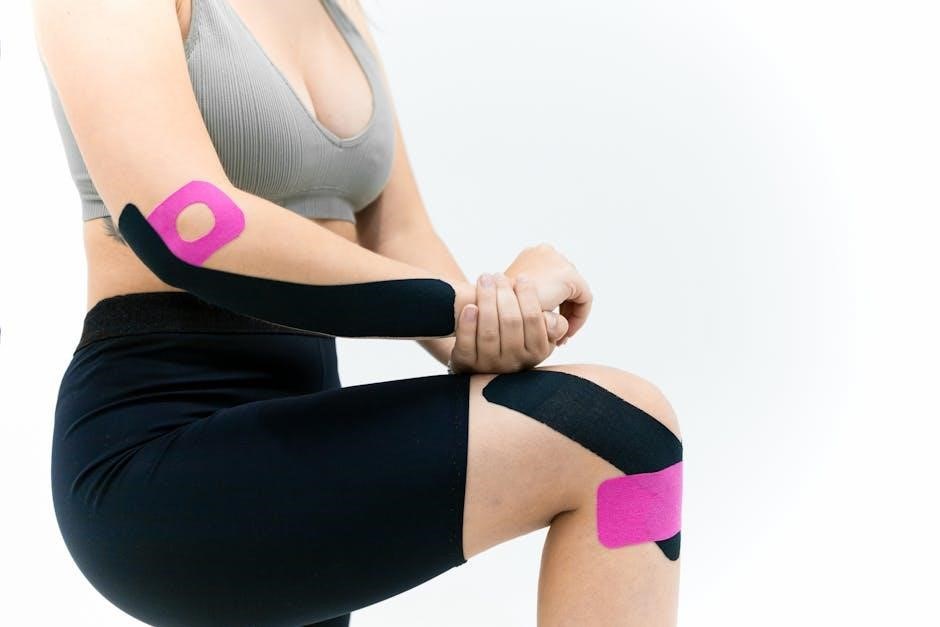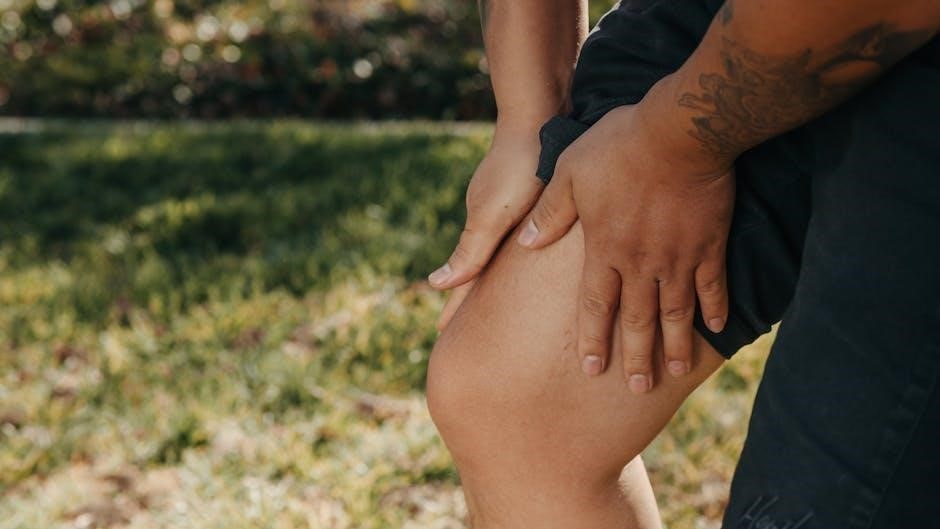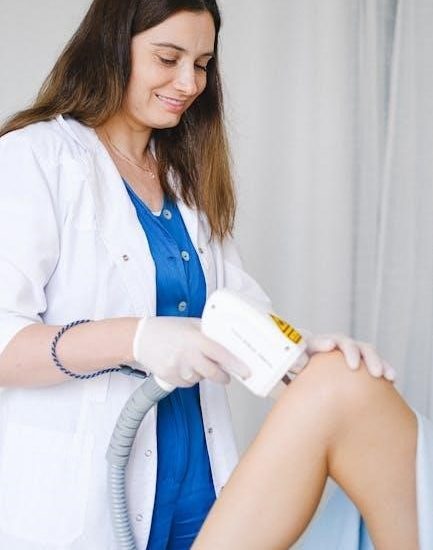Knee Ability Zero is a comprehensive step-by-step guide designed to improve knee health and prevent injuries. It focuses on simple, equipment-free exercises like Tibialis Raises and Knees Over Toes calf raises. The program emphasizes strength, flexibility, and proper movement patterns to achieve pain-free mobility and enhance athletic performance. Perfect for athletes and non-athletes alike, it offers a zero-equipment, zero-gym approach to building bulletproof knees.
1.1 Overview of the Knee Ability Zero Program
The Knee Ability Zero program is a structured, 12-week system focusing on strengthening the knees and surrounding areas. It emphasizes exercises like Tibialis Raises, FHL Raises, and Knees Over Toes calf raises. Designed for individuals at all fitness levels, the program requires zero weights or gym memberships. Workouts are scheduled three times a week, with deload phases to ensure recovery. The program aims to improve joint mobility, prevent injuries, and enhance overall lower body strength. Its simplicity and effectiveness make it accessible to both athletes and non-athletes seeking healthier, pain-free knees.
1.2 Importance of Knee Health
Knee health is crucial for maintaining mobility, stability, and overall quality of life. Strong, healthy knees enable efficient movement, reduce injury risk, and support athletic performance. Neglecting knee health can lead to chronic pain, limited mobility, and increased risk of injuries like patellofemoral pain or ligament strains. Addressing knee health early prevents long-term issues, enhances daily functionality, and reduces reliance on medical interventions. Prioritizing knee strength and flexibility fosters independence and active lifestyles, making it a cornerstone of long-term wellness and injury prevention.
1.3 Key Principles of the Program
Knee Ability Zero is built on three core principles: progressive overload, proper movement patterns, and consistency. The program emphasizes strengthening the muscles around the knee, including the tibialis anterior and flexor hallucis longus, through exercises like Tibialis Raises and Knees Over Toes calf raises. By focusing on controlled, incremental progress, it ensures sustainable gains in strength and flexibility. The zero-equipment approach makes it accessible to everyone, while the structured schedule guarantees measurable improvements over time, fostering long-term knee health and resilience.
The Science Behind Knee Health
Knee health relies on muscle strength, joint stability, and proper movement mechanics. Understanding these elements helps address common injuries and improve overall knee function effectively.
2.1 Anatomy of the Knee Joint
The knee joint is a complex hinge joint formed by the articulation of the femur (thigh bone), tibia (shin bone), and patella (kneecap). It is stabilized by ligaments, including the anterior cruciate ligament (ACL) and posterior cruciate ligament (PCL), which prevent excessive forward or backward movement. The medial and lateral collateral ligaments (MCL and LCL) provide side-to-side stability. Cartilage, particularly the menisci, cushions the joint, reducing friction and absorbing shock. The synovial membrane produces fluid to lubricate the joint, ensuring smooth movement and minimizing wear on the bones and cartilage.
2.2 Common Knee Injuries and Their Causes
The knee is prone to injuries such as ACL tears, meniscus tears, and patellar tendinitis, often caused by sudden twists, jumps, or repetitive stress. Overuse and poor movement patterns can lead to conditions like IT band syndrome and jumper’s knee. Direct blows to the knee or falls can result in fractures or ligament sprains. Weakness in surrounding muscles and improper alignment during exercises like squats or lunges also contribute to knee injuries. Addressing these issues through targeted exercises and proper form is crucial for long-term knee health and functionality.
2.3 Role of Strength and Flexibility in Knee Health
Strength and flexibility are crucial for maintaining healthy knees. Weak muscles around the knee joint, such as the quadriceps and hamstrings, can lead to instability and increased injury risk. Flexibility, particularly in the calves and hip flexors, ensures proper movement patterns and reduces strain on the knee. Strengthening exercises like Tibialis Raises and Knees Over Toes calf raises improve joint stability and protect against injuries. Without adequate strength and flexibility, activities like running or squatting can lead to conditions such as patellofemoral pain or ligament sprains, emphasizing the need for targeted exercises to enhance knee resilience.

The Zero Program Structure
The program follows a 12-week schedule with workouts on Monday, Wednesday, and Friday. It includes deload phases to prevent overtraining and integrates seamlessly with daily activities, requiring no equipment.
3.1 Weekly Workout Schedule
The Knee Ability Zero program follows a structured weekly schedule, with workouts on Monday, Wednesday, and Friday. Each session focuses on three core exercises: Tibialis Raises, Flexor Hallucis Longus (FHL) Raises, and Knees Over Toes (KOT) calf raises. The program starts with 25 repetitions of each exercise and gradually increases intensity. This schedule allows for consistency and progression, ensuring steady improvement in knee strength and flexibility. The routine is designed to fit seamlessly into daily life, requiring minimal time and no specialized equipment.
3.2 Exercise Progression and Deload Phases
Knee Ability Zero incorporates a 12-week structure with strategic exercise progression and deload phases. The program alternates between intensification phases, where repetitions and intensity increase, and deload weeks, which focus on active recovery. This approach prevents overtraining and allows the knees to adapt and strengthen. Deload phases involve reducing exercise volume while maintaining movement quality, ensuring long-term consistency and injury prevention. The program’s progression is designed to be sustainable, with gradual increases in challenge to promote continuous improvement without risking overuse injuries.
3.3 Integration with Daily Activities
Knee Ability Zero is designed to seamlessly integrate into daily life, enhancing functional movement and reducing pain during everyday activities. The program’s exercises, such as Tibialis Raises and Knees Over Toes calf raises, strengthen the lower body and improve joint mobility, making tasks like walking, climbing stairs, and sitting more comfortable. By focusing on natural movement patterns and minimal equipment, the program encourages consistency and long-term sustainability. This approach ensures that users can maintain healthy knees while performing daily tasks, whether they’re athletes or non-athletes, without requiring significant time or resources.

Core Exercises in Knee Ability Zero
Core exercises include Tibialis Raises, FHL Raises, and KOT calf raises. These movements enhance strength, mobility, and injury prevention with minimal equipment.
4.1 Tibialis Raise Exercise
The Tibialis Raise is a foundational exercise in the Knee Ability Zero program, targeting the tibialis anterior muscle. It improves ankle dorsiflexion, essential for proper knee mechanics during activities like squats and lunges. By strengthening this muscle, individuals can reduce the risk of knee valgus and patellofemoral pain. The exercise involves lifting the toes while keeping the heel grounded, promoting better joint stability and movement patterns. Regular practice enhances foot and knee alignment, contributing to overall lower limb health and athletic performance.
4.2 Flexor Hallucis Longus (FHL) Raise
The Flexor Hallucis Longus (FHL) Raise is a key exercise in the Knee Ability Zero program, focusing on the deep plantar flexors. It strengthens the FHL muscle, which plays a crucial role in toe and ankle mobility. By improving this muscle’s function, individuals can enhance their ability to perform movements requiring toe flexion, such as sprinting or jumping. The exercise involves lifting the big toe while keeping the other toes relaxed, promoting better foot mechanics and reducing the risk of injuries like shin splints or plantar fasciitis.
4.3 Knees Over Toes (KOT) Calf Raise
The Knees Over Toes (KOT) Calf Raise is a foundational exercise in the Knee Ability Zero program, designed to enhance knee function and calf strength. By allowing the knees to move past the toes during the raise, it targets the soleus and gastrocnemius muscles, improving ankle mobility and reducing knee strain. This exercise is particularly effective for addressing tight calves and preventing injuries such as shin splints. Regular practice of the KOT Calf Raise promotes better posture, balance, and overall lower limb stability, making it essential for both athletes and individuals seeking improved knee health.

Benefits of the Program
Knee Ability Zero offers numerous benefits, including injury prevention, enhanced joint mobility, and improved athletic performance. It strengthens key muscles, reducing knee pain and boosting overall fitness without equipment or gym memberships, making it accessible to everyone.
5.1 Injury Prevention and Recovery
Knee Ability Zero excels in injury prevention and recovery by targeting the muscles around the knee, such as the tibialis anterior and flexor hallucis longus. These exercises strengthen the lower extremities, improving joint stability and reducing the risk of common injuries like patellofemoral pain and knee valgus. The program’s focus on proper movement patterns and progressive overload helps users recover from existing injuries while building resilience. Many users report significant reductions in knee pain and improved mobility, making it an effective solution for both prevention and rehabilitation.
5.2 Improved Joint Mobility and Strength
Knee Ability Zero enhances joint mobility and strength through targeted exercises like Tibialis Raises and Knees Over Toes calf raises. These movements improve ankle dorsiflexion and reduce stiffness, allowing for better range of motion. Strengthening the muscles around the knee, such as the tibialis anterior and flexor hallucis longus, enhances joint stability and overall lower limb function. The program’s zero-equipment approach makes it accessible to everyone, ensuring consistent progress in mobility and strength without the need for gym memberships or specialized gear.
5.3 Enhanced Athletic Performance
Knee Ability Zero significantly enhances athletic performance by improving knee function, reducing injury risk, and boosting overall lower limb strength. The program’s focus on exercises like Tibialis Raises and Knees Over Toes calf raises enhances explosiveness and agility. Athletes experience improved speed, power, and endurance, while the zero-equipment approach ensures accessibility. By strengthening the knees and surrounding muscles, the program helps athletes perform at higher intensities and recover faster. This makes it an ideal solution for those aiming to optimize their training and competition performance without compromising on knee health.

Real-World Applications
Knee Ability Zero is widely used by athletes and non-athletes to enhance knee health and performance. Its exercises are applied in sports training, fitness routines, and daily activities, promoting injury prevention and mobility.
6.1 Success Stories and Testimonials
Knee Ability Zero has transformed lives, with users reporting significant improvements in knee health. Athletes and non-athletes alike share testimonials of eliminating chronic pain and enhancing mobility. Many credit the program’s simple, equipment-free exercises for their success. For example, a professional basketball player eliminated knee pain in 12 weeks, while a CrossFit coach improved joint mobility. These stories highlight how the program empowers individuals to regain strength and confidence, making it a trusted resource for knee health and injury prevention.
6.2 Use in Sports and Fitness Training
Knee Ability Zero is widely adopted in sports and fitness training for its effectiveness in enhancing performance and preventing injuries. The program’s focus on Tibialis Raises and Knees Over Toes calf raises improves flexibility, strength, and joint mobility, making it ideal for athletes. Many professionals, including basketball players and CrossFit coaches, have incorporated these exercises into their routines, reporting improved agility and reduced knee pain. The program’s adaptable structure allows it to benefit both elite athletes and recreational fitness enthusiasts, making it a versatile tool for optimizing lower body mechanics and achieving peak performance.
6.3 Application for Non-Athletes
Knee Ability Zero is equally beneficial for non-athletes, offering a simple, equipment-free approach to improving knee health. The program’s exercises, such as Tibialis Raises and Knees Over Toes calf raises, are designed to enhance daily mobility and reduce pain. Many individuals with chronic knee pain have found relief by incorporating these routines into their lifestyle. Whether for walking, climbing stairs, or maintaining active lifestyles, the program provides a practical solution for strengthening knees without the need for gym memberships or advanced fitness levels, making it accessible to everyone.

Expert Endorsements and Reviews
Orthopedic surgeons and physical therapists praise Knee Ability Zero for its effective, science-backed approach to knee health. Athletes and non-athletes alike report significant improvements in pain reduction and mobility.
7.1 Feedback from Orthopedic Surgeons
Orthopedic surgeons endorse Knee Ability Zero for its ability to strengthen knee joints and reduce injury risk. Many report improved patient outcomes, with reduced surgical recovery times and lower infection rates. The program’s focus on strength and mobility aligns with post-surgical rehabilitation goals, enhancing patient recovery. Surgeons highlight the program’s effectiveness in addressing chronic knee pain and improving joint function, making it a valuable resource for both preventive care and post-operative rehabilitation. Its non-invasive, exercise-based approach is widely recommended for patients seeking to avoid or recover from knee surgeries.
7.2 Reviews from Physical Therapists
Physical therapists consistently praise Knee Ability Zero for its effective, evidence-based approach to improving knee health. Many highlight the program’s focus on strengthening the lower extremities and enhancing flexibility, which aligns with rehabilitation goals. The exercises, such as Tibialis Raises and Knees Over Toes calf raises, are commended for their simplicity and effectiveness in reducing chronic pain and improving joint mobility. Therapists also appreciate the program’s adaptability, making it suitable for both athletes and non-athletes. Overall, it is widely endorsed as a valuable tool for preventing injuries and promoting long-term knee health.
7.3 Athlete Testimonials
Athletes who have incorporated Knee Ability Zero into their training routines report significant improvements in knee health and performance. Many professional athletes praise the program for its ability to reduce chronic knee pain and enhance agility. The zero-equipment approach is particularly valued, allowing athletes to train effectively anywhere. Testimonials highlight how the program’s focus on strength and mobility has helped prevent injuries and improve overall athletic performance. Athletes also appreciate the simplicity and sustainability of the exercises, making Knee Ability Zero a cornerstone of their fitness regimens.
Knee Ability Zero offers a transformative approach to knee health, combining simple exercises with proven results to eliminate pain and enhance performance. Start your journey today for stronger knees and a pain-free life.
8.1 Summary of Key Takeaways
Knee Ability Zero provides a straightforward, equipment-free approach to improving knee health. By focusing on exercises like Tibialis Raises, FHL Raises, and Knees Over Toes calf raises, the program strengthens the lower body. It emphasizes proper movement patterns, flexibility, and progressive overload. The structured 12-week schedule, including deload phases, ensures sustainable progress. Users report reduced pain, improved mobility, and enhanced athletic performance. With real success stories and expert endorsements, the program offers a practical solution for athletes and non-athletes alike to achieve long-term knee health and functionality.
8.2 Final Thoughts on Knee Health
Knee health is foundational for both daily life and athletic performance. Knee Ability Zero offers a practical, accessible approach to achieving strong, pain-free knees without equipment or gym memberships. By focusing on proper movement patterns and progressive exercises, individuals can prevent injuries and enhance mobility. The program’s emphasis on simplicity and consistency makes it suitable for all fitness levels. Prioritizing knee health now can prevent future issues, ensuring long-term functionality and an active lifestyle. Investing time in these exercises is a wise decision for overall well-being and physical resilience.
8.3 Encouragement to Start the Program
Embarking on the Knee Ability Zero program is a proactive step toward transforming your knee health. With its simple, equipment-free exercises, anyone can begin, regardless of fitness level. The program’s focus on foundational strength and mobility ensures lasting results. By committing just minutes a day, you can prevent future pain and enhance your overall athleticism. Don’t wait—start your journey to pain-free knees today. Download the guide, follow the steps, and experience the transformative power of strong, resilient knees. Your body will thank you for this investment in long-term health and mobility.





